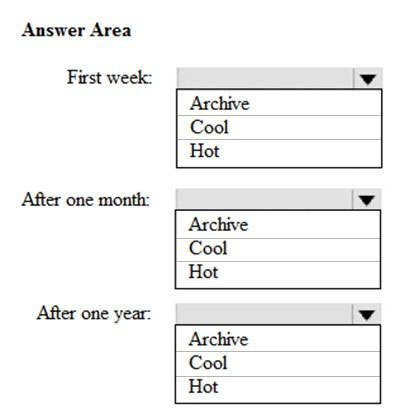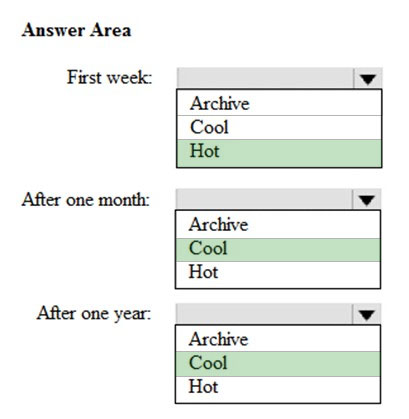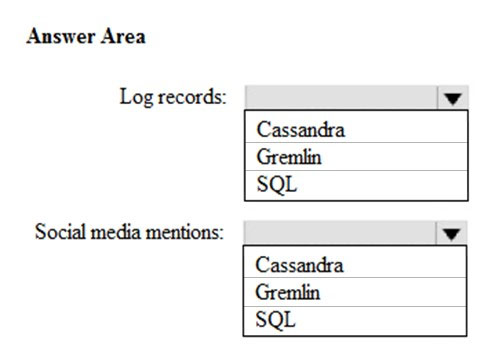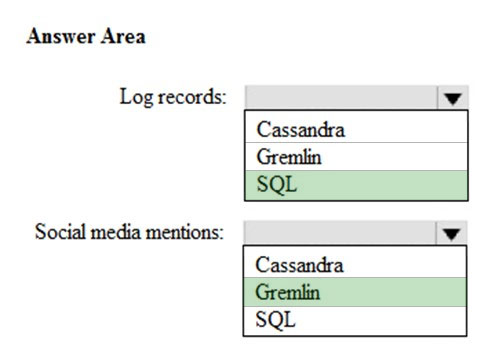Microsoft DP-201 Exam Practice Questions (P. 4)
- Full Access (208 questions)
- Six months of Premium Access
- Access to one million comments
- Seamless ChatGPT Integration
- Ability to download PDF files
- Anki Flashcard files for revision
- No Captcha & No AdSense
- Advanced Exam Configuration
Question #16
You are designing an application. You plan to use Azure SQL Database to support the application.
The application will extract data from the Azure SQL Database and create text documents. The text documents will be placed into a cloud-based storage solution.
The text storage solution must be accessible from an SMB network share.
You need to recommend a data storage solution for the text documents.
Which Azure data storage type should you recommend?
The application will extract data from the Azure SQL Database and create text documents. The text documents will be placed into a cloud-based storage solution.
The text storage solution must be accessible from an SMB network share.
You need to recommend a data storage solution for the text documents.
Which Azure data storage type should you recommend?
- AQueue
- BFiles
- CBlob
- DTable
Correct Answer:
B
Azure Files enables you to set up highly available network file shares that can be accessed by using the standard Server Message Block (SMB) protocol.
Incorrect Answers:
A: The Azure Queue service is used to store and retrieve messages. It is generally used to store lists of messages to be processed asynchronously.
C: Blob storage is optimized for storing massive amounts of unstructured data, such as text or binary data. Blob storage can be accessed via HTTP or HTTPS but not via SMB.
D: Azure Table storage is used to store large amounts of structured data. Azure tables are ideal for storing structured, non-relational data.
Reference:
https://docs.microsoft.com/en-us/azure/storage/common/storage-introduction https://docs.microsoft.com/en-us/azure/storage/tables/table-storage-overview
B
Azure Files enables you to set up highly available network file shares that can be accessed by using the standard Server Message Block (SMB) protocol.
Incorrect Answers:
A: The Azure Queue service is used to store and retrieve messages. It is generally used to store lists of messages to be processed asynchronously.
C: Blob storage is optimized for storing massive amounts of unstructured data, such as text or binary data. Blob storage can be accessed via HTTP or HTTPS but not via SMB.
D: Azure Table storage is used to store large amounts of structured data. Azure tables are ideal for storing structured, non-relational data.
Reference:
https://docs.microsoft.com/en-us/azure/storage/common/storage-introduction https://docs.microsoft.com/en-us/azure/storage/tables/table-storage-overview
send
light_mode
delete
Question #17
You are designing an application that will have an Azure virtual machine. The virtual machine will access an Azure SQL database. The database will not be accessible from the Internet.
You need to recommend a solution to provide the required level of access to the database.
What should you include in the recommendation?
You need to recommend a solution to provide the required level of access to the database.
What should you include in the recommendation?
- ADeploy an On-premises data gateway.
- BAdd a virtual network to the Azure SQL server that hosts the database.
- CAdd an application gateway to the virtual network that contains the Azure virtual machine.
- DAdd a virtual network gateway to the virtual network that contains the Azure virtual machine.
Correct Answer:
B
When you create an Azure virtual machine (VM), you must create a virtual network (VNet) or use an existing VNet. You also need to decide how your VMs are intended to be accessed on the VNet.
Incorrect Answers:
C: Azure Application Gateway is a web traffic load balancer that enables you to manage traffic to your web applications.
D: A VPN gateway is a specific type of virtual network gateway that is used to send encrypted traffic between an Azure virtual network and an on-premises location over the public Internet.
Reference:
https://docs.microsoft.com/en-us/azure/virtual-machines/network-overview
B
When you create an Azure virtual machine (VM), you must create a virtual network (VNet) or use an existing VNet. You also need to decide how your VMs are intended to be accessed on the VNet.
Incorrect Answers:
C: Azure Application Gateway is a web traffic load balancer that enables you to manage traffic to your web applications.
D: A VPN gateway is a specific type of virtual network gateway that is used to send encrypted traffic between an Azure virtual network and an on-premises location over the public Internet.
Reference:
https://docs.microsoft.com/en-us/azure/virtual-machines/network-overview
send
light_mode
delete
Question #18
HOTSPOT -
You are designing an application that will store petabytes of medical imaging data
When the data is first created, the data will be accessed frequently during the first week. After one month, the data must be accessible within 30 seconds, but files will be accessed infrequently. After one year, the data will be accessed infrequently but must be accessible within five minutes.
You need to select a storage strategy for the data. The solution must minimize costs.
Which storage tier should you use for each time frame? To answer, select the appropriate options in the answer area.
NOTE: Each correct selection is worth one point.
Hot Area:

You are designing an application that will store petabytes of medical imaging data
When the data is first created, the data will be accessed frequently during the first week. After one month, the data must be accessible within 30 seconds, but files will be accessed infrequently. After one year, the data will be accessed infrequently but must be accessible within five minutes.
You need to select a storage strategy for the data. The solution must minimize costs.
Which storage tier should you use for each time frame? To answer, select the appropriate options in the answer area.
NOTE: Each correct selection is worth one point.
Hot Area:

Correct Answer:

First week: Hot -
Hot - Optimized for storing data that is accessed frequently.
After one month: Cool -
Cool - Optimized for storing data that is infrequently accessed and stored for at least 30 days.
After one year: Cool -
Incorrect Answers:
Archive: Optimized for storing data that is rarely accessed and stored for at least 180 days with flexible latency requirements (on the order of hours).
References:
https://docs.microsoft.com/en-us/azure/storage/blobs/storage-blob-storage-tiers

First week: Hot -
Hot - Optimized for storing data that is accessed frequently.
After one month: Cool -
Cool - Optimized for storing data that is infrequently accessed and stored for at least 30 days.
After one year: Cool -
Incorrect Answers:
Archive: Optimized for storing data that is rarely accessed and stored for at least 180 days with flexible latency requirements (on the order of hours).
References:
https://docs.microsoft.com/en-us/azure/storage/blobs/storage-blob-storage-tiers
send
light_mode
delete
Question #19
You are designing a data store that will store organizational information for a company. The data will be used to identify the relationships between users. The data will be stored in an Azure Cosmos DB database and will contain several million objects.
You need to recommend which API to use for the database. The API must minimize the complexity to query the user relationships. The solution must support fast traversals.
Which API should you recommend?
You need to recommend which API to use for the database. The API must minimize the complexity to query the user relationships. The solution must support fast traversals.
Which API should you recommend?
- AMongoDB
- BTable
- CGremlin
- DCassandra
Correct Answer:
C
Gremlin features fast queries and traversals with the most widely adopted graph query standard.
Reference:
https://docs.microsoft.com/th-th/azure/cosmos-db/graph-introduction?view=azurermps-5.7.0
C
Gremlin features fast queries and traversals with the most widely adopted graph query standard.
Reference:
https://docs.microsoft.com/th-th/azure/cosmos-db/graph-introduction?view=azurermps-5.7.0
send
light_mode
delete
Question #20
HOTSPOT -
You are designing a new application that uses Azure Cosmos DB. The application will support a variety of data patterns including log records and social media relationships.
You need to recommend which Cosmos DB API to use for each data pattern. The solution must minimize resource utilization.
Which API should you recommend for each data pattern? To answer, select the appropriate options in the answer area.
NOTE: Each correct selection is worth one point.
Hot Area:

You are designing a new application that uses Azure Cosmos DB. The application will support a variety of data patterns including log records and social media relationships.
You need to recommend which Cosmos DB API to use for each data pattern. The solution must minimize resource utilization.
Which API should you recommend for each data pattern? To answer, select the appropriate options in the answer area.
NOTE: Each correct selection is worth one point.
Hot Area:

Correct Answer:

Log records: SQL -
Social media mentions: Gremlin -
You can store the actual graph of followers using Azure Cosmos DB Gremlin API to create vertexes for each user and edges that maintain the "A-follows-B" relationships. With the Gremlin API, you can get the followers of a certain user and create more complex queries to suggest people in common. If you add to the graph the Content Categories that people like or enjoy, you can start weaving experiences that include smart content discovery, suggesting content that those people you follow like, or finding people that you might have much in common with.
Reference:
https://docs.microsoft.com/en-us/azure/cosmos-db/social-media-apps

Log records: SQL -
Social media mentions: Gremlin -
You can store the actual graph of followers using Azure Cosmos DB Gremlin API to create vertexes for each user and edges that maintain the "A-follows-B" relationships. With the Gremlin API, you can get the followers of a certain user and create more complex queries to suggest people in common. If you add to the graph the Content Categories that people like or enjoy, you can start weaving experiences that include smart content discovery, suggesting content that those people you follow like, or finding people that you might have much in common with.
Reference:
https://docs.microsoft.com/en-us/azure/cosmos-db/social-media-apps
send
light_mode
delete
All Pages
